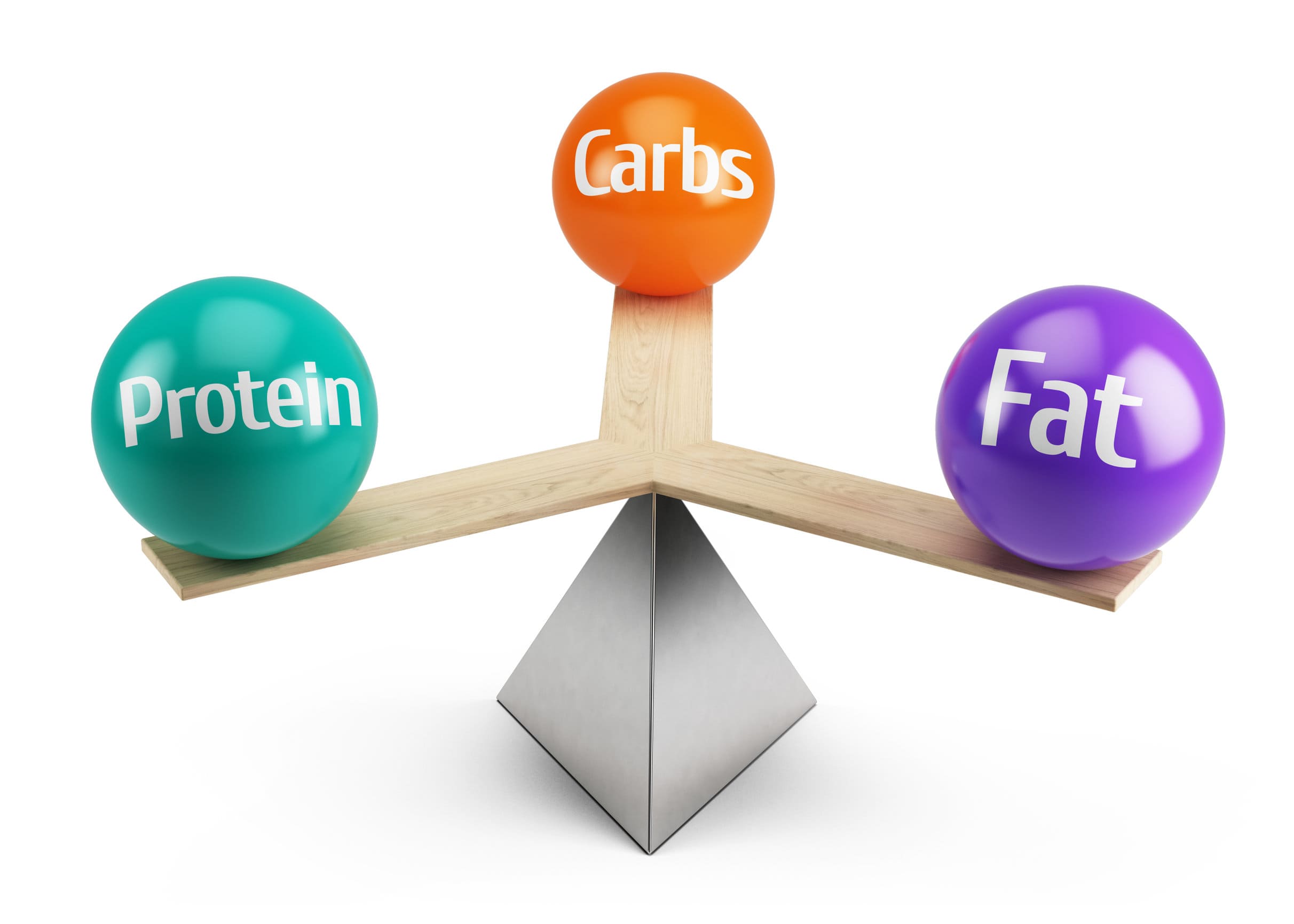If you are setting up your diet for weight loss, then you may want to decide how much of each different macronutrient you will consume. Check out How to Calculate Calories to get this sorted first! This article provides a brief guide for how to choose a macronutrient ratio for your weight loss as well as other key considerations for making your macronutrient ratio work for you.
The different macronutrient groups
There are four macronutrient groups: protein, carbohydrate, fat and alcohol. They have different roles. Protein has a very diverse role, from being used to make every cell in our body, to playing a role in the different chemical reactions that take place, to making our hair and our muscles strong! Carbohydrate and fat are great sources of energy and we keep stores of them so that we can be healthy, perform at our best and stay alive. Fats also play other important roles and are important for our cells being healthy and the effective communication of different signals throughout the body. They have different caloric values per gram: protein 4 calories/g, carbs 4 calories/g, fat 9 calories/g and alcohol 7 calories/g.
What is a good protein intake for weight loss?
Protein intake is always the priority with any diet – especially with weight loss. Enough protein is key for preventing loss of lean muscle, promoting fat loss, supporting overall health, as well keeping hunger at bay.
For fat loss, an intake of 1.6-2.4 g/kg may be optimal (Amy et al. 2018, Oliver et al. 2019). If you are especially lean / train a lot, a protein intake of up to 2.8 g/kg may benefit you (Aragon et al. 2017). If you are very overweight on the other hand, then opt for a slightly lower intake of 1.5-1.6 g/kg bodyweight (Kim et al. 2016).
Depending on your weight, you may want to work out your protein requirement based upon your optimal weight rather than your current weight. For those the are classified overweight or obese, you will find that the basic amount of protein in grams per kg of bodyweight may result in your significantly overeating protein.
Any change in protein should be done in a graduated fashion, allowing your liver and kidneys time to adapt to the higher protein intake.
Anyone with underlying kidney issues, history of kidney stones, gout etc, should work with a professional to establish a protein goal that is appropriate for their given situation.
We have a great team of qualified nutritionists that specialise in weight loss from a health optimisation perspective.
How do I calculate carbohydrates and fats for weight loss?
Research indicates that for weight loss, there is no winner when it comes to low carb versus a low-fat diet when calories are matched (Gardner et al. 2018). However, what does matter is how different levels of carbs and fat within your diet influence how well you function. The balance between carbs and fats will influence your energy levels, how well you manage blood sugar levels and therefore subsequent hunger levels – these are all key factors that impact how easy it is to adhere to your nutrition plan and caloric deficit!
Additionally, your own unique needs, such as genetics, lifestyle, underlying health issues, training and of course preferences, will determine the balance of carbohydrate and fats that will work best for you.
A useful place to start is with a relatively balanced macronutrient intake and ensure that fats are not any lower than 20% for hormonal health (for some individuals this may need to be more). In general, 30% protein, 20-40% fat and 30-50% carbs is a relatively balanced approach which provides you with ranges for you to choose macronutrient ratios that are more suited for you. You’d want to shoot more for the 50% carbs if you are someone who is very active and trains a lot. If you are more overweight, then choosing a lower amount of carbohydrates may be beneficial, particularly if there are some underlying insulin resistance issues or known conditions like type 2 diabetes and PCOS.
An example macronutrient ratio for weight loss
For a 70 kg female who is shooting for a protein intake of 1.8 g/kg, her protein intake would be 126 g per day. Since there are 4 calories in every gram of protein, this would account to 504 calories.
If her caloric intake goal is 1800, then protein accounts for 28% of her caloric intake. She would then need to deduct 504 calories from 1800 (1296 calories), to work out her remaining macronutrient distribution.
By dividing the 1296 calories into two (648 calories), we can then work out how many grams of fat and carbs the female will be consuming. This works out to be 72g of fats (648 divided by 9 (9 calories per gram of fat)) and 162g of carbs (648 divided by 4 (4 calories per gram of carbs)).
As a macronutrient ratio split, this works out to be 28% protein, 36% fats and 36% carbs.
Therefore, for a simplified approach, you could simply choose a macronutrient ratio of 30% protein, 35% fat and 35% carb.
Why you need to focus on food, not just macros
Processed versus whole food: consuming processed versus whole food which is of equal caloric intake will likely influence subsequent energy intake by impacting levels of fullness. Many processed foods have added ingredients and sugars which can influence your desire to further consume those types of foods. Additionally, any food that has been processed has had its food matrix broken down and therefore will be easier for you to consume because you simply do not have to break down the food itself. Compare 30g of whole almonds versus 30g of almond butter. The amount of energy required to digest the whole almonds versus the almond butter will be greater because the almond butter has had its food matrix broken down. This subsequently quite often results in the almond butter being over consumed compared to whole almonds!
Thermic effect of food: is the amount of energy required to digest and absorb food. Foods that have a higher thermic effect cost more energy to break down. Protein is the macronutrient with the highest thermic effect – check out The importance of protein for weight loss. However, whole foods also have a higher thermic effect than processed foods. For example, a chicken breast has a higher thermic effect than protein powder. Generally, foods that are less processed, so found in their whole/original form, as well as foods that are raw, will have a higher thermic effect.
Nutrient density of food: consuming a diet rich in nutrients – so your vitamins and minerals – are important for you to function and feel well. You want to have enough energy to be able to live your life, as well as perform well during training sessions. Nutrients are essential for processes to take place in your body effectively. Feeling energetic will contribute to being active and contribute to that energy deficit.
Volume filling effect of food: when you are in an energy deficit you may experience hunger. You therefore need to choose foods and balance meals appropriately to both meet your caloric needs (energy deficit) and for you to be full. It will likely benefit you on a weight loss journey to choose volume filling foods rather than energy dense foods. Volume filling foods tend to have a higher content of fibre and water – so think vegetables. For example, compare two meals of 300 calories, one is calorie dense and the other is volume filling – the calorie dense one is 4 x rice cakes and two tablespoons of peanut butter, the volume filling one is tuna steak, cauliflower rice, sautéed kale, green salad and a quarter avocado. The volume filling one is likely to fill you up for a longer period of time, whereas the calorie dense rice cakes and nut butter you are likely to be able to consume regardless of hunger.
Fibre content of food: fibre is another one like protein which will help you feel full and satisfied, as well as having many great health benefits. Check out The importance of fibre for weight loss. Fibre feeds the gut – it it is broken down in the large intestine and provides a great source of energy for the cells there! Some fibre does provide energy and it is unclear which types of fibre do. Be sure to include fibre as carbohydrate when tracking to avoid stalling your progress.
Key takeaways
Each macronutrient has a different caloric value: protein 4 calories/g, carbs 4 calories/g, fat 9 calories/g and alcohol 7 calories/g. Each macronutrient has a different role and including a balance of the different macronutrients may be a great place to start.
To calculate macronutrient intake, begin with protein intake: shoot for an intake between 1.5-2.4 g/kg and go for the lower end if you are overweight and the higher end if you are leaner/train a lot. Once you have established protein intake, deduct the caloric value of protein from your daily calorie intake and split the remaining calories between carbs and fat by dividing by the relevant calorie amount.
Focus on food, not just macros: by briefly considering the type of food you consume and then predominantly choose whole real food, including protein and two non-starchy veg at most meals.
Work with a weight loss specialist
Our clinicians specialise in weight loss. All qualified nutrition professionals have backgrounds in the exercise industries and a vast amount of experience coaching clients towards their goals.
Check out our weight loss specialist page, where you can learn more about our services, clinicians and the support and programs that we offer.
If you would like to enquire to work with one of our practitioners, please click the button below:
[widgetkit id=”643″]


